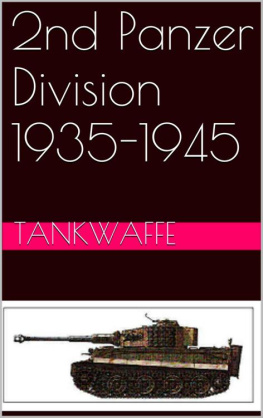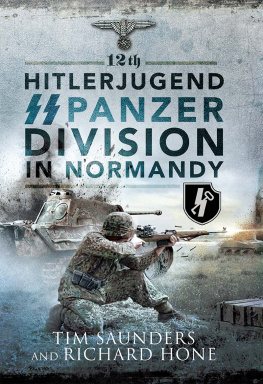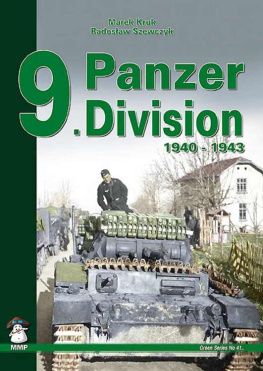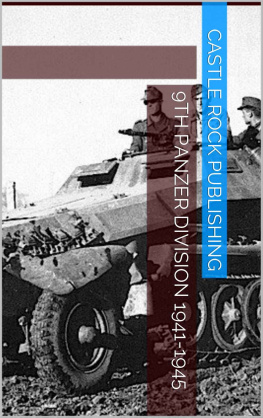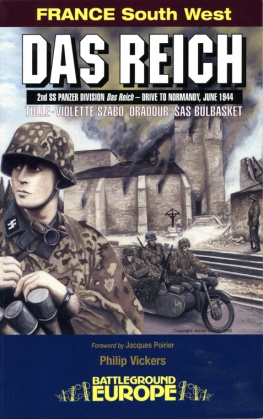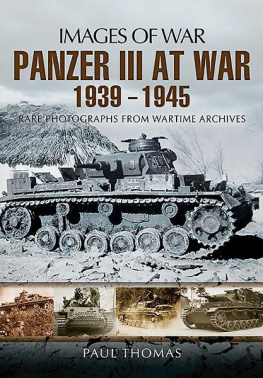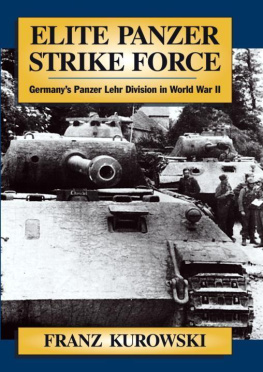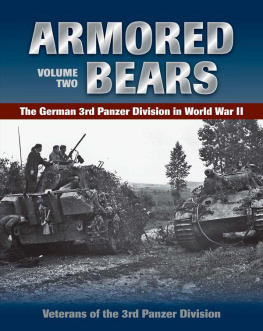Tankwaffe - 2nd Panzer Division 1935-1945
Here you can read online Tankwaffe - 2nd Panzer Division 1935-1945 full text of the book (entire story) in english for free. Download pdf and epub, get meaning, cover and reviews about this ebook. year: 2014, publisher: Tankwaffe Publishing, genre: Non-fiction. Description of the work, (preface) as well as reviews are available. Best literature library LitArk.com created for fans of good reading and offers a wide selection of genres:
Romance novel
Science fiction
Adventure
Detective
Science
History
Home and family
Prose
Art
Politics
Computer
Non-fiction
Religion
Business
Children
Humor
Choose a favorite category and find really read worthwhile books. Enjoy immersion in the world of imagination, feel the emotions of the characters or learn something new for yourself, make an fascinating discovery.
- Book:2nd Panzer Division 1935-1945
- Author:
- Publisher:Tankwaffe Publishing
- Genre:
- Year:2014
- Rating:5 / 5
- Favourites:Add to favourites
- Your mark:
- 100
- 1
- 2
- 3
- 4
- 5
2nd Panzer Division 1935-1945: summary, description and annotation
We offer to read an annotation, description, summary or preface (depends on what the author of the book "2nd Panzer Division 1935-1945" wrote himself). If you haven't found the necessary information about the book — write in the comments, we will try to find it.
2nd Panzer Division 1935-1945 — read online for free the complete book (whole text) full work
Below is the text of the book, divided by pages. System saving the place of the last page read, allows you to conveniently read the book "2nd Panzer Division 1935-1945" online for free, without having to search again every time where you left off. Put a bookmark, and you can go to the page where you finished reading at any time.
Font size:
Interval:
Bookmark:


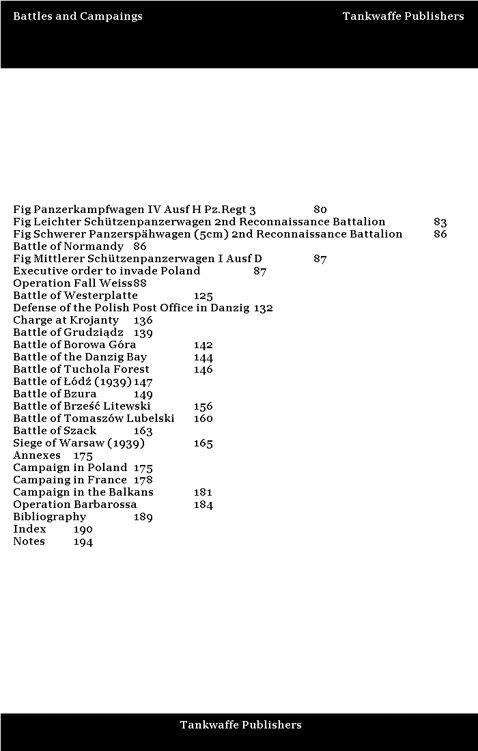

 2nd Panzer Division
2nd Panzer DivisionThis unit was originally formed on October 15th, 1935. In 1938, itmoved to Austria after the annexation of that Country, taking on alarge number of Austrians into its ranks. The Division then was usedin the Polish Campaign in 1939, suffering heavy losses against thePoles. After Poland, the Division saw action in the West as a part of12.Armee/Gen.Kdo. XIX.Armeekorps, starting in the Eifel area. InMay, the 2.Panzer-Division took Abbeville along the English Coastwhich helped seal the ring around the Allied forces in the DunkirkPocket.
After the Campaign in the West, the 2.Panzer-Division spent time onoccupation duty in Poland. During the months in Poland, the 2ndwas reorganized and it provided units to other forming divisions, aswell as taking on new units itself. It was then moved to Rumania inApril, 1941 for action in the Campaign in the Balkans. In the Balkans,the 2nd helped take Athens in Greece, along with the 6.Gebirgs-Division.
After the Campaign in the Balkans ended the wheeled units of the2.Panzer-Division moved to Yugoslavia via Albania and were entrained in Croatia for Germany. The tracked elements of the divisionwere loaded for sea transport in the Greek port of Patras to Tarent inthe south of Italy. On May 21st, 1941 the German transport shipsMarburg and Kybfels carrying the tracked elements of the divisionwere sunk by a recently laid British mine barrage. A considerablenumber of armored vehicles were thus lost causing any deployementof the division to be seriously delayed. The 2.Panzer-Division was inGermany when the Invasion of the Soviet Union began and in July of1941 was transfered to Poland. In August, 1941 it was transfered tothe south of France, and in September it was finally entrained forRussia, arriving at the front in October 1941.
For the Campaign against the Soviet Union the 2.Panzer-Divisionwas under the control of Armeegruppe Mitte, first seeing combat inthe Fall of 1941 in the region of Roslawl, Wjasma, Gshatsk, and eventually the outskirts of Moscow. With the onset of winter the 2.PanzerDivision was pushed back from the gates of Moscow by the massiveSoviet Winter Counter-Offensive in the of 1941/42. The division continued to see action in the East as a part of Armeegruppe Mitte fighting in the massive defensive battles of 1942 including Rzhev, theKursk Summer Offensive in July, 1943, and the defensive battlesalong the Dnieper River later. In all of these actions the 2.Panzer-Division suffered heavily.
In December of 1944 the 2.Panzer-Division was withdrawn from theEastern Front and sent to rest and refit in France. After a period ofrest and occupation duties in France, the division saw heavy fightingagainst the Allied Armies during the D-Day Invasion in June, 1944.After the desperate battles for Normandy the 2.Panzer-Division wasnearly destroyed in the Falaise Gap. It managed a breakout from thepocket and suffered staggering losses while doing so.
The 2.Panzer-Division was once more refit and reformed, this time atWittlich in the Eifel area of Germany where it absorbed the remainsof the 352.Infantry-Division. The division again saw action, this timeduring the Wacht Am Rhein Offensive in December, 1944. Again, thedivision suffered heavily.
 Fig Tactical insignia 2nd Panzer Division
Fig Tactical insignia 2nd Panzer Division As WWII drew to a close in March and April of 1945 the weak remains of the 2.Panzer-Division were absorbed into the ThuringenPanzer-Brigade which fought in the middle Mosel region and later inFulda. The unit surrendered to American forces at Plauen and Koetzing in May, 1945.
The 2nd Panzer Division (2. Panzer-Division) was created in 1935,and stationed in Austria after the Anschluss. It participated in thecampaigns in Poland (1939) and France (1940), and then returned toPoland for occupation duties (19401941). It took part in the Balkanscampaign (1941) and then transferred to the Russian Front in September 1941. It fought with Army Group Center in the battles of Moscow (1941) and Kursk (1943). After heavy losses on the Russian Frontit was sent to France for rehabilitation (1944). It fought in Normandyand was almost completely destroyed in the Falaise Pocket (1944). Itwas rebuilt once more and fought in the Battle of the Bulge (1944)and in the defense of the Rhine (1945), surrendering to the Americans at war's end.
The 2nd Panzer Division was created by the Wehrmacht in the city ofWrzburg on 15 October 1935 from two armoured regiments, the 3rdPanzer Regiment and the 4th Panzer Regiment under the control ofOberst Heinz Guderian.
During the Anschluss of Austria by the Third Reich, assisted by Nazielements within Austria, the division was sent to form a part of thegarrison in the Austrian capital of Vienna. At the outbreak of the Second World War the division was bolstered by a contingent of localAustrians, up to the point where the division was nicknamed theVienna Division.
In early September 1939, at the beginning of the war, the 2nd PanzerDivision took part in the invasion of Poland as a part of the XII Panzer Corps, of the 14th Army (Wehrmacht), Army Group South. Basedin newly formed Slovakia, the objectives of the division initially werethe taking of the city of Krakow, where it came against the improvised and well coordinated by Stanislaw Maczek Mechanized Division(made out of largest Polish tank unit, 10th Cavalry Brigade and lightbut usually highly mobile infantry of the Border Protection Corps andthe local police). Troughout the campaign it suffered heavy losses,particularly on 18 September in a bitter tank battle.
On the other hand, during the campaign, soldiers of the 2nd PanzerDivision committed atrocities against prisoners of the Polish Army.On 5 September, some Polish soldiers who were apprehended nearToporzysko-Bystra were removed from their unit and executed underthe assumption that they were attempting to flee.
In January 1940, the 2nd Division was reassigned to the Westernfront, around the area of Eifel. When May came of that same year, theunit took part in the Battle of France, as a part of the XIX ArmyCorps (Germany) under the command of Heinz Guderian, their former commander. The kampfgruppe of which the division formed apart was under the command of Ewald von Kleist. The divisionhelped the push through the Ardennes and was involved in fightingin Belgium and the Mosel River valley. On 17 May, along with the 1stPanzer Division they managed to hold the banks of the River Oise,spearheaded an attack Moy, and took the town of Peronne in theSomme on 19 May; arriving in the town of Abbeville on 20th. Laterthey would form the armoured element which flanked the British Expeditionary Army and forced their extraction from the European Continent in Dunkirk, while engaging the French 2nd Armoured Divisionled by General Charles de Gaulle who would carry on to lead the FreeFrench forces. The invasion was typical of newly developed Blitzkriegtactics used by the German army which utilised armoured elementsunder the support of the Luftwaffe.
Font size:
Interval:
Bookmark:
Similar books «2nd Panzer Division 1935-1945»
Look at similar books to 2nd Panzer Division 1935-1945. We have selected literature similar in name and meaning in the hope of providing readers with more options to find new, interesting, not yet read works.
Discussion, reviews of the book 2nd Panzer Division 1935-1945 and just readers' own opinions. Leave your comments, write what you think about the work, its meaning or the main characters. Specify what exactly you liked and what you didn't like, and why you think so.

